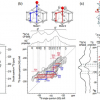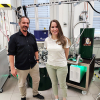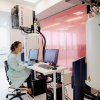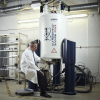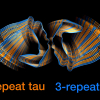
An antioxidant found in green tea may increase levels of p53, a natural anti-cancer protein, known as the “guardian of the genome” for its ability to repair DNA damage or destroy cancerous cells. A study of the direct interaction between p53 and the green tea compound, epigallocatechin gallate (EGCG), points to a new target for cancer drug discovery.
“Both p53 and EGCG molecules are extremely interesting. Mutations in p53 are found in over 50 % of human cancer, while EGCG is the major anti-oxidant in green tea, a popular beverage worldwide”, said Chunyu Wang, corresponding author and a professor of biological sciences at Rensselaer Polytechnic Institute. “Now we find that there is a previously unknown, direct interaction between the two, which points to a new path for developing anti-cancer drugs. Our work helps to explain how EGCG is able to boost p53’s anti-cancer activity, opening the door to developing drugs with EGCG-like compounds.”
Wang, a member of the Rensselaer Center for Biotechnology and Interdisciplinary Studies, has used nuclear magnetic resonance (NMR) spectroscopy to study specific mechanisms in Alzheimer’s disease and cancer, including p53, which he described as “arguably the most important protein in human cancer.” NMR and other analytical techniques were used in the study of the binding of EGCG.
P53 has several well-known anti-cancer functions, including halting cell growth to allow for DNA repair, activating DNA repair and initiating programmed cell death (apoptosis) if DNA damage cannot be repaired. The N-terminal domain of the protein has a flexible shape and, therefore, can potentially serve several functions depending on its interaction with multiple molecules.
Wang’s team found that the interaction between EGCG and p53 preserves the protein against degradation. Typically, after being produced within the body, p53 is quickly degraded when the N-terminal domain interacts with a protein called MDM2. This regular cycle of production and degradation holds p53 levels at a low constant.
“Both EGCG and MDM2 bind at the same place on p53, the N-terminal domain, so EGCG competes with MDM2”, said Wang. “When EGCG binds with p53, the protein is not being degraded through MDM2, so the level of p53 will increase with the direct interaction with EGCG, and that means there is more p53 for anti-cancer function. This is a very important interaction.”
“By developing an understanding of the molecular-level mechanisms that control key biochemical interactions linked to devastating illnesses such as cancer and Alzheimer’s disease, Chunyu’s research is laying the groundwork for new and successful therapies,” said Curt Breneman, dean of the Rensselaer School of Science.


